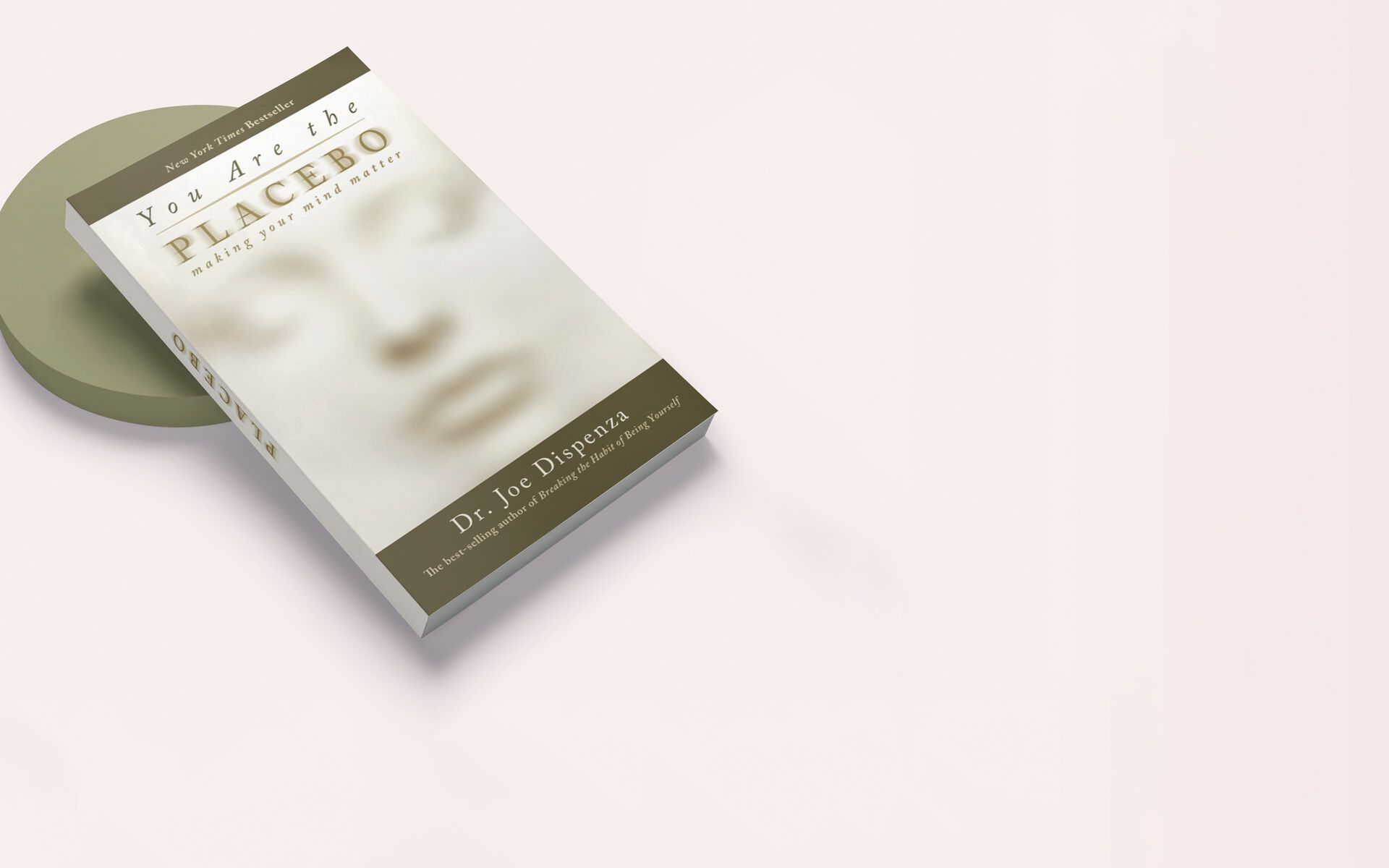You Are the Placebo

In This Article
-
Our thoughts and beliefs can induce chemical reactions in the body that can lead to real changes in our physiology; we can use this principle to improve our health and our lives.
-
According to quantum physics, the observer can collapse the wave function, meaning that by observing a particle, the observer can determine its state or position. Dr. Dispenza suggests that in the same way, by focusing on a particular outcome or state of health, we can collapse the wave function and make it a reality.
-
Meditation can be used to create new neural pathways in the brain, which can allow us to overcome limiting beliefs and to generate new realities for ourselves.
Can our thoughts and beliefs have a powerful effect on our health and well-being? Dr. Joe Dispenza, a chiropractor and neuroscientist, explores how this can be possible in his book “You Are the Placebo.” Dr. Dispenza argues that the placebo effect, which is the phenomenon where a person’s health improves simply because they believe a treatment will work, is not just a psychological phenomenon but a physiological one as well. He explains that our thoughts and beliefs can induce chemical reactions in the body that can lead to real changes in our physiology, and that we can use this principle to improve our health and our lives.
The book begins by discussing the placebo effect, which is the phenomenon where a person’s symptoms can improve simply because they believe they are taking a real treatment, even if it is just a sugar pill. Dr. Dispenza argues that this effect is not just limited to medicine but can also be applied to other areas of life, such as relationships, career, and health.
Dr. Dispenza then explains how the mind and body are connected and how thoughts and emotions can affect physical health. He argues that our beliefs and perceptions shape our reality and that by changing these beliefs and perceptions, we can change the way our body functions. He suggests that by using our imagination and visualization, we can generate new neural pathways in the brain and reprogram our biology. He provides various examples of people who have used the placebo effect to heal themselves from various ailments such as cancer and chronic pain.
Here are a few examples of the placebo effect that he uses to illustrate the power of the mind in shaping our physical reality:
- A woman with multiple sclerosis who was able to improve her symptoms and even walk again after using visualization and meditation techniques.
- A man with a terminal illness who was able to extend his life by several months and improve the quality of his life by using the placebo effect.
- A study of people with irritable bowel syndrome (IBS) found that those who were given a placebo treatment experienced a significant reduction in symptoms, even though they knew they were taking a sugar pill.
- A study on patients with Parkinson's disease found that those who were given a placebo treatment saw an improvement in symptoms, even though the placebo did not contain any active medication.
These examples demonstrate that the placebo effect is not just a temporary phenomenon but a lasting one that can lead to real and measurable changes in the body. Dr. Joe Dispenza argues that by harnessing the power of the placebo effect, we can take control of our health and well-being and generate the lives we want for ourselves.
Quantum physics
The book also delves into the concept of quantum physics and how it relates to the mind-body connection. Dr. Dispenza argues that our thoughts and beliefs can change the way matter behaves and that by understanding this principle, we can change our reality. Dispenza explains that according to quantum physics, the observer and the observed are intimately connected, and that our thoughts and beliefs can influence the way that reality is perceived and experienced. He also argues that the placebo effect is a manifestation of this principle, and that our thoughts and beliefs can manifest actual changes in the body at the quantum level, influencing the behavior of atoms and molecules.
Dr. Dispenza also states that according to quantum physics, the observer can collapse the wave function, meaning that by observing a particle, the observer can determine its state or position. He suggests that in the same way, by focusing on a particular outcome or state of health, we can collapse the wave function and make it a reality.
He describes the concept of entanglement which, in quantum physics, states that particles can be connected in such a way that the state of one particle can instantaneously affect the state of another, even if they are separated by large distances. He suggests that this principle can be applied to our thoughts and emotions, and that we can become entangled with other people and with the environment, influencing their realities as well.
Dr. Dispenza also explores the idea of superposition, which states that a particle can exist in multiple states or locations at the same time. He argues that this principle can be applied to our thoughts and beliefs, and that we can hold multiple beliefs and states of being simultaneously, allowing us to experience different realities and outcomes.
These examples demonstrate how Dr. Dispenza uses principles of quantum physics to explain the placebo effect and the power of the mind in shaping our physical reality. He argues that by understanding and utilizing the principles of quantum physics, we can harness the power of the placebo effect to improve our health and well-being.
Meditation
Dr. Dispenza also provides practical tools and techniques for readers to use in their own lives to harness the power of the placebo effect. These include meditation, visualization, and affirmations. He also emphasizes the importance of committing to a goal and taking consistent action for lasting change. He explains that when we meditate, we enter a state of deep relaxation, which allows us to access different parts of the brain and to change the way that we perceive and experience reality. He argues that by meditating, we can change our brainwaves, which can lead to changes in the body, such as reducing stress and inflammation and increasing the production of healing chemicals.
He also explains that meditation can be used to generate new neural pathways in the brain, which can allow us to overcome limiting beliefs and to generate new realities for ourselves. He suggests that by meditating, we can change the way that we perceive and experience reality, and that this can lead to changes in the body, such as healing from illnesses and improving our overall health and well-being. He insists that meditation can be used to make possible a state of focused attention, which allows us to access the deeper parts of the mind and to direct the power of our thoughts and beliefs towards healing and well-being.
Power of prayer and meditation
Dr. Dispenza’s focus on the importance of meditation in healing reminded me of the similarities between meditation and prayer. Prayer and meditation are both practices that involve connecting with a higher power or spiritual force, and they also share some similarities in terms of their effects on the mind and body.
Both prayer and meditation involve a form of focused attention and concentration, which can help to reduce stress and anxiety, and improve overall well-being. They also both can be used as a tool to help individuals focus on their intentions, beliefs, and emotions, which can lead to positive changes.
Similar to the importance of meditation, there have been many studies conducted on the relationship between prayer and health:
- A study published in the Journal of Behavioral Medicine found that individuals who regularly engaged in prayer or meditation had lower blood pressure compared to those who did not.
- A study conducted by the National Institutes of Health found that individuals with rheumatoid arthritis who regularly prayed had less pain and stiffness compared to those who did not pray.
- A study published in the Journal of the American Medical Association found that individuals with advanced-stage cancer who received prayer from others had a significantly better quality of life compared to those who did not receive prayer.
- A study published in the International Journal of Behavioral Medicine found that individuals who regularly engaged in prayer or meditation had lower levels of stress and anxiety compared to those who did not.
- A study published in the Journal of Religion and Health found that individuals who regularly engaged in prayer had a lower risk of developing depression compared to those who did not pray.
These studies, along with others, suggest a positive relationship between prayer and health and that prayer can have a beneficial impact on various physical and mental health outcomes. However, it's important to note that more research is needed to fully understand the complex relationship between prayer and health, and that the results may vary depending on the individuals and the context.
In summary, both prayer and meditation involve connecting with a higher power or spiritual force, and they share some similarities in terms of their effects on the mind and body, such as reducing stress and anxiety and improving overall well-being. The main difference is that prayer is focused on asking for help or guidance from a higher power, while meditation is more focused on connecting with one’s self and the present moment.
Overall, “You Are the Placebo” is a thought-provoking and empowering book that offers a new perspective on the mind-body connection and the power of the placebo effect. Dr. Dispenza's writing is clear and easy to understand, and he provides ample scientific research and real-life examples to support his claims. The book encourages readers to take responsibility for their health and well-being and empowers them with the tools to make positive change in their lives.
References
Dispenza, J. (2014). You are the placebo: Making your mind better. Published by Hay House Inc.









